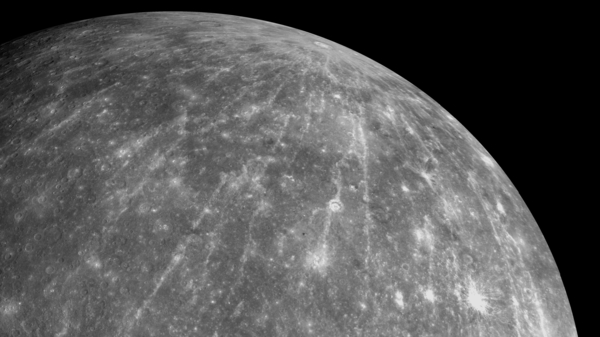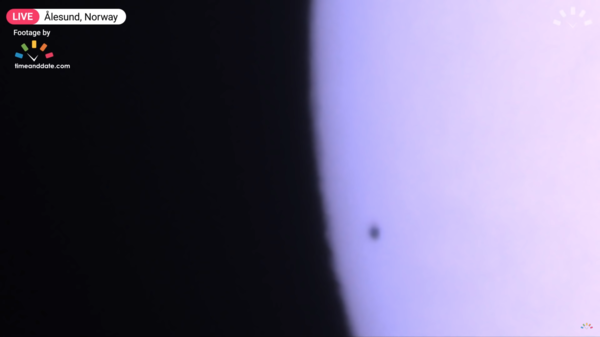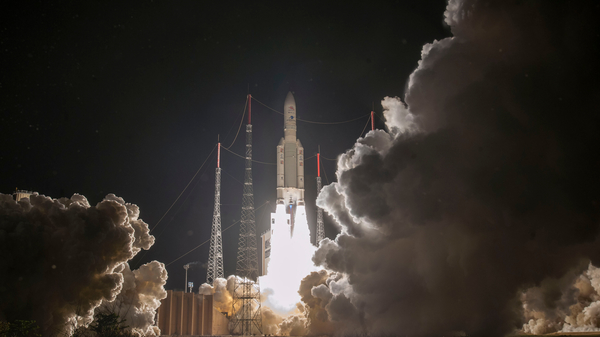Mercury: The Iron Planet
Mercury consists of a large iron core surrounded by a thin rocky shell.

Mercury’s cratered surface gives it an appearance similar to our Moon.
© NASA/Johns Hopkins University Applied Physics Laboratory/Carnegie Institution of Washington
The Crescent Moon, Saturn & Venus align in January 2025
A Brief Overview of Mercury
Mercury is the closest planet to the Sun, and the smallest planet in the solar system. It has a large iron core that accounts for about three-quarters of its mass. By contrast, Earth’s iron core accounts for only one-third of its mass.
Compare the sizes and order of the planets
A rocky outer shell surrounds the planet’s core. Mercury has almost no atmosphere, and its grey surface is covered with impact craters caused by asteroids and comets.
Where Is Mercury in the Sky?
Find and track Mercury with our Interactive Night Sky Map
Check the weather in your town or city
When Is the Best Time to See Mercury?
Warning: Never point binoculars or a telescope in the direction of the Sun—it can cause permanent eye damage. Do not try to observe Mercury while any part of the Sun is above the horizon.
Because Mercury is small and lies close to the Sun, it is a challenge to observe. It can be seen with the naked eye shortly before sunrise or soon after sunset.
The best time to catch Mercury is within a week or so of its greatest elongation: this is when Mercury appears to be at its farthest distance from Sun as seen from Earth. These periods occur twice every 116 days or so (roughly every four months).
Greatest elongation west is when Mercury is farthest from the Sun in the morning sky. Greatest elongation east is when the two bodies are farthest apart in the evening sky. In between these times, Mercury’s swift orbit carries it either directly behind the Sun as seen from Earth (superior conjunction), or in front of it (inferior conjunction).
Next superior conjunction: February 9, 2025
Next greatest elongation east: March 8, 2025
Next inferior conjunction: March 24, 2025
Next greatest elongation west: April 21, 2025
Previous greatest elongation west: December 25, 2024
Previous inferior conjunction: December 6, 2024
Previous greatest elongation east: November 16, 2024
Previous superior conjunction: September 30, 2024
How far is Mercury from Earth right now?
Other Times to See Mercury
Mercury often comes clearly into view when the Moon completely covers the Sun during a total solar eclipse.
When is the next total solar eclipse?
The planet also produces its own mini-eclipses: 13 or 14 times a century, Mercury passes across the Sun’s disk. The next transit of Mercury—which can only be observed with specialized equipment—will be on November 12/13, 2032.

Tiny Mercury is silhouetted against the Sun in this image from timeanddate.com’s live stream of the November 11, 2019 transit.
©timeanddate.com
How Long Is a Day and a Year?
The Sun’s tidal forces have given Mercury a 3-to-2 spin-orbit coupling: Mercury spins on its axis three times for every two orbits around the Sun.
Mercury’s tropical year is about 88 Earth days. A solar day on the planet is approximately 176 Earth days.
How Many Moons Does Mercury Have?
Mercury and Venus are the only planets in the solar system with no moons.

The BepiColombo mission to Mercury blasts off from Kourou in French Guiana on October 20, 2018.
©ESA-CNES-Arianespace
Human Exploration of Mercury
There have only been three missions to Mercury. In 1974 and 1975, Mariner 10 made one flyby of Venus and three flybys of Mercury. About four decades later, MESSENGER spent around four years orbiting Mercury before crashing into its surface on April 30, 2015.
The latest—and still ongoing—mission to Mercury is BepiColombo. This spacecraft is named after Giuseppe “Bepi” Colombo (1920-1984), an astronomer who discovered Mercury’s spin-orbit coupling. He also proposed the use of gravity assist maneuvers (see below) to visit the planet.
How Long Does It Take to Get to Mercury?
Although Mariner 10 reached Mercury in about five months, it was traveling too fast to go into orbit around the planet.
Spacecraft speed up as they get closer to the Sun: to slow down, they need to perform a complicated series of gravity assist maneuvers around Earth, Venus, and Mercury itself. For the MESSENGER and BepiColombo missions, this increases the journey time to around seven years.
Mariner 10 used a gravity assist maneuver around Venus to control its orbit around the Sun—this enabled it to make more than one flyby of Mercury.
When spacecraft are traveling away from the Sun, they can use gravity assist maneuvers to speed up. For example, Galileo made flybys of Venus and Earth to accelerate it toward Jupiter.
Mariner 10
- Launched: November 3, 1973
- Arrived: March 29, 1974 (first flyby)
- Journey time: 4 months and 26 days
MESSENGER
- Launched: August 3, 2004
- Arrived: March 18, 2011 (entered orbit, following six gravity assist maneuvers)
- Journey time: 6 years, 7 months, and 15 days
BepiColombo
- Launched: October 20, 2018
- Scheduled arrival: December 5, 2025 (entry into orbit, following nine gravity assist maneuvers)
- Journey time: 7 years, 1 month, and 15 days
All dates are shown in UTC.